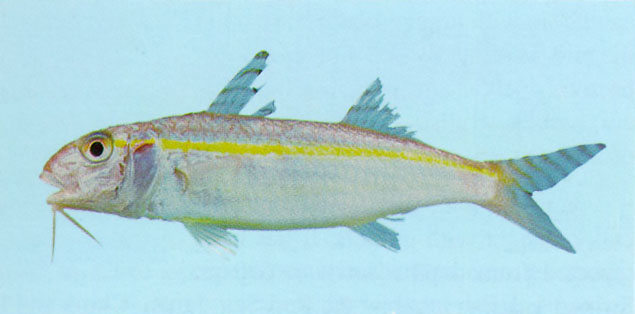
Upeneus moluccensis (Bleeker, 1855)
It has an elongated body which has a sub-cylindrical anterior portion which becomes compressed towards the tail that is deeply forked. Like other mullids, it bears a pair of barbels on the chin. The back is pinkish-red in colour contrasting with the white belly, from which it is separated by single longitudinal yellow stripe which runs from the operculum to the caudal fin peduncle. The dorsal fins are yellow in colour with 3 parallel red bars while the pectoral fin is a similar colour but lacks markings and the pelvic fin is colourless. The upper lobe of caudal fin is whitish and has 5 or 6 black diagonal bars while the lower lobe is unmarked except for the hind margin which is black as the second bar of the upper lobe extends along it.
Laskaridis, K. (1948b). Contribution to the biology of the fish Mulloides auriflamma (Forsk.). Proceedings of the Hellenic Hydrobiological Institute 2: 103-118
1947
UNA
Golband goatfish
Found in coastal waters with a muddy substrate, at depths of 10–80m on continental or insular shelf regions. Forms large schools. Usually fast swimming with short stops to feed. Sold fresh in markets. Utilized for fish meal. Valued also for its roe.
No impact on biodiversity has been reported to date. Yet, potential competition with the native Mullus barbatus and M. surmuletus, might lead to native species’ extirpation.
No impact on health and ecosystem services has been reported to date. Nevertheless, extirpation of native mullids, which are highly commercial, might impact fisheries. On the other hand, since U. moluccensis is edible, it might become an additional source of income for the local fishers. Indeed, in some areas it is sold along with the native M. surmuletus.
Yes
No
Records of Upeneus moluccensis
Sites where Upeneus moluccensis has been recorded in the Hellenic Seas.

